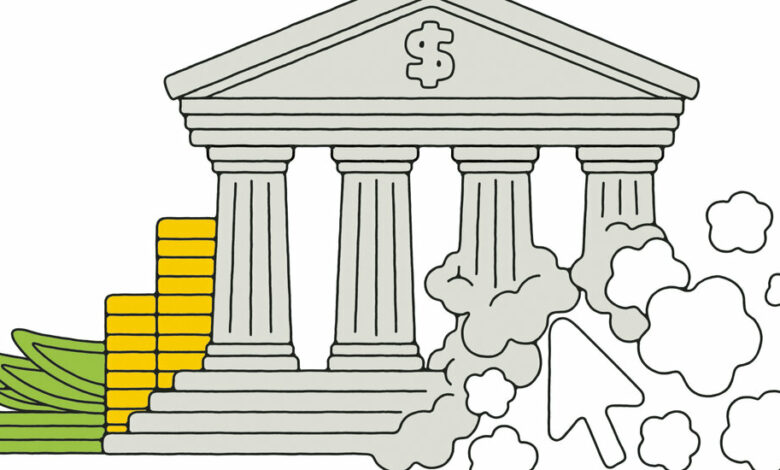What happens if your bank is no longer a real bank and your money disappears?

For nearly a century, it has been a certainty to deposit your savings in a government-insured bank: if the institution goes bankrupt, your money is protected up to $250,000.
What if that is no longer the case?
The promise of bank insurance — a tenet of consumer protection in the U.S. since the Great Depression — is now being tested by a crisis surrounding online-only lenders with hundreds of millions of dollars in deposits between them. Customer accounts have been frozen, preventing people from withdrawing their savings. Most depositors have no idea where their money has gone or whether they will get any of it back.
The unrest began this spring with the bankruptcy of Synapse Technology, the kind of company you’ve probably never heard of unless you’ve read all the fine print on your bank statements. It managed banking software for fast-growing online lenders with names like Juno, Yieldstreet and Yotta.
Backed by some of Silicon Valley’s biggest venture capitalists, the startups offer accounts with lower fees and much higher interest rates than traditional brick-and-mortar banks. Their slick websites tout insurance from the Federal Deposit Insurance Corporation, the U.S. agency that promises to repay lost funds.
Unlike stodgy, brick-and-mortar institutions, this group’s message is that banking can be downright fun. “Play games. Win big,” says Yotta, who has a lottery-style system that boosts returns for a lucky few.
This model is becoming increasingly popular, especially among people in their twenties and thirties, and is legal.
The problem is that these startups may look and feel like banks but they aren’t. They simply collect money from customers and pass it on through financial technology intermediaries like Synapse to traditional banks that may have only one physical location and minimal online presence. The banks, which include Evolve Bank & Trust of West Memphis, Arkansas, are the ones actually handling depositors’ money, according to the documents.
If one link in this chain breaks, it can become very difficult for people to access their money.
When Synapse filed for bankruptcy in the spring, the company said it had just $2 million in cash on hand and owed many times that amount.
Shortly thereafter, account holders at Juno, Yotta and other banks, with nearly $300 million in deposits and no direct relationship with Synapse, were locked out of their funds.
The only one of the above crew that is actually a chartered bank, and thus covered by FDIC insurance, is Evolve. And because Evolve itself did not go bankrupt, the online lenders’ customers did not qualify for automatic federal bank insurance
“It’s really unprecedented,” said Jason Mikula, a former Goldman Sachs product manager who now writes a financial newsletter. “There’s no direct, statutory authority for the FDIC or any other agency to intervene.”
The companies involved point fingers at each other. Yotta, who repeatedly advertised its products as “FDIC insured,” has told customers it was powerless to help because it had no money of its own. Synapse founder Sankaet Pathak blamed Evolve, writing in a Medium post that it was “unnecessary and punitive” for the bank to freeze the funds. Neither Mr Pathak nor representatives for Juno and Yieldstreet responded to requests for comment.
Yotta founder Adam Moelis, son of prominent investment banker Ken Moelis, said he took responsibility for trying to resolve the situation, but not causing it: “The responsibility of the banks and Synapse was to store and move money and to provide proper oversight.”
He added: “This is basic stuff. While we feel terrible about the impact this has had on our customers, it is not our fault that these parties are unable to account for and reconcile tens of millions of dollars.”
Even to experts, it’s unclear what happens next. While some of the frozen $300 million in bank accounts has been released to customers, according to documents in Synapse’s bankruptcy case, the defunct company’s court-appointed trustee has told the court that there is a “shortfall” of as much as $95 million in funds that Synapse managed for lenders.
Thomas Holmes, a spokesman for Evolve, said the bank was holding onto $46 million of the funds pending court guidance because it discovered “numerous significant discrepancies” in Synapse’s documentation.
The bankruptcy judge has said he suspects tens of millions of dollars will never be found, but he is powerless to force regulators to intervene. “This is a very, very unusual situation,” Judge Martin R. Barash said at a hearing last week.
The one doing the blaming in this Möbius accusation is the customers, who these lending startups call “end users.” To have a chance of getting their money back, they first need to figure out who has it.
Many were told at one point that they had debit cards and accounts with Evolve, but have now learned that it was another, unnamed bank that had their money. Evolve’s Mr. Holmes said the bank transferred “all end-user funds” to other banks at Synapse’s request, but declined to identify them. “It’s complicated,” he wrote in an email Friday, declining to elaborate.
In interviews, Customers were shocked to find out they were not eligible for immediate federal insurance.
“It all sounded like a normal bank to me,” said Erick Baum, 45, an information technology professional in Sacramento who transferred about $30,000 of his savings from JPMorgan Chase to Yotta after hearing about it on a popular financial advice channel on YouTube.
Mark Hingle, a paramedic in Gretna, Louisiana, was irritated that regulators would not intervene even though they were so quick to act last years to help struggling lenders targeting high-net-worth clients like Silicon Valley Bank and First Republic. In those cases, depositors were able to access their accounts within days after regulators auctioned off the failed banks and deployed federal insurance funds.
“I didn’t play with this money,” said Mr. Hingle, 33, who has $60,000 stuck in his bank account and said he couldn’t afford back surgery without access to his savings. “I thought this was an FDIC-insured bank.”
Representatives for the FDIC and the Federal Reserve, the top banking regulator, declined to comment. An FDIC spokesman pointed to a letter the regulator sent to the bankruptcy trustee, which said it was “deeply disturbing” about Synapse’s collapse and that it had responded to more than 1,000 complaints and inquiries from people who were unable to access their money.
During Synapse’s bankruptcy hearing last week, a depositor who said she was about to sell her home to pay her bills noted that she had filed dozens of bankruptcy petitions. requests for help from the FDIC The agency’s only response, she said, was a copy of the answers to its “Frequently Asked Questions.”
Another depositor said, “The FDIC has put the responsibility on the consumer.” A third previously told the court he considered harming himself.
Judge Barasch said he had no answers. He suggested that depositors hire their own attorneys to sue those involved.




